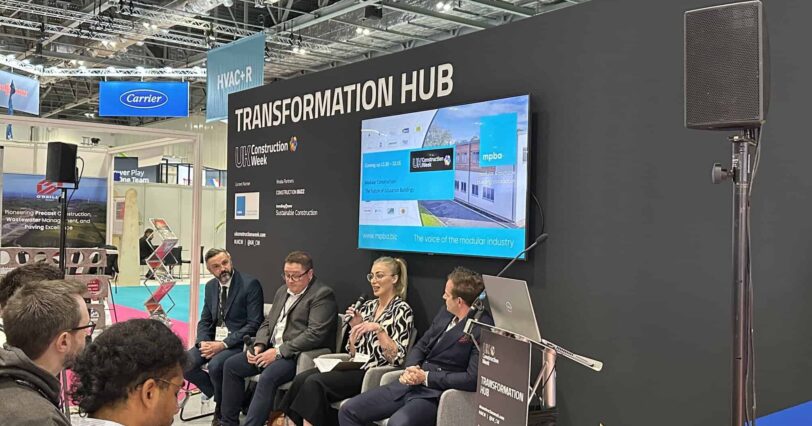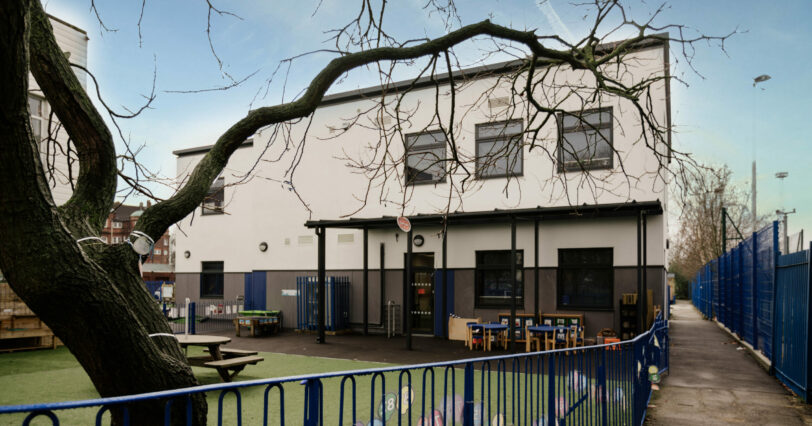Our newly-commissioned report by the Centre for Economics and Business Research (Cebr) entitled “Off-site manufacturing and 20-year operating leases: is this the future for school buildings?” is out now.
This report examines the pressing need for new school buildings and explores how 20 year operating leases and the Schoolhaus® design can combine to deliver significant value-for-money improvements.
Executive summary
This is the summary of a report by the Centre for Economics and Business Research (Cebr) that examines the issue of school funding and assesses the value-for-money benefits associated with off-site manufactured buildings and operating leases with nominally fixed rental payments for those buildings, as compared with alternative (including traditional) construction and procurement options.
The investigation reveals a pressing need for new school buildings, as:
Pupil attendance at schools is forecast to grow by approximately 10% between 2017 and 2026;
Many classrooms are already overcrowded, with 11% of state-funded primary classes and 7% of secondary classes accommodating over 30 pupils each; and
Much of the schools estate is aging, with 60% of school buildings built before 1976.
These drivers are exacerbated by constrained school budgets and the increasing cost pressures associated with delivering top-quality education. The Department for Education has well-publicised funding pressures, which have been made all the more acute by the UK’s fiscal deficit.
In light of the these budgetary pressures, modern methods of construction have the potential to help meet the demand for new school buildings, whilst also alleviating cost pressures through lower lifecycle costs associated with the types of building that are delivered through modern methods.
The analysis explores how the Schoolhaus® design – itself based on off-site manufactured buildings and on offer on an operating lease-basis – has the potential to provide significant value-for-money benefits, which would help alleviate the budgetary pressures in education. But the Schoolhaus® design would also offer wider spillover impacts that produce economic benefits beyond what can be captured in traditional value-for-money assessment. For instance, the buildings intelligently communicate their energy efficiency measures through monitoring equipment that displays in real time the levels of energy consumption and renewable energy generation in the building. Further, the airtight construction and high efficiency particle air (HEPA) filter provide high levels of air quality, a particularly important feature in heavily polluted areas.
The results of our study reveal Cebr’s key findings that the Schoolhaus® design can be associated with clear economic benefits and demonstrate value for money for the public sector. For a 20-year operating lease – not to be confused with a Private Finance Initiative (PFI) – on a Two-Form Entry (2 FE) of size 2,200m2, Cebr’s analysis suggests that:
In cases in which the capital costs of Schoolhaus® and traditional designs are assumed, for simplicity, to be the same and at the ESFA funding envelope, Schoolhaus® offers a present value of cumulative savings of £1.45 million over a 60 year period. This amounts to a 22% saving compared to traditional builds.
In the more realistic scenario in which the lower anticipated capital costs of the Schoolhaus® are factored into the analysis, then the Schoolhaus® option can be procured more competitively than the ESFA funding envelope (whether on a purchase or an operating lease basis), and generates a present value of cumulative savings of £1.85 million over 60 years. This results in the saving relative to traditional builds growing to 28%.
However, not only does the operating lease represent value for money relative to traditional build options, funding could come from schools’ revenue budgets, thereby freeing up capital funds for use elsewhere. This suggests that:
A present value of savings of £1.2 billion could be made over 60 years if 500 new schools (as defined in Section 5.8) were built to have the capital, energy, maintenance and lifecycle (O&M) properties of Schoolhaus® and procured on a 20 year operating lease basis, as opposed to the capital purchase of more traditional builds that do not have these efficiencies. This potential saving could be as high as £4.8 billion if 2,000 new schools (as defined in section 5.8) were procured and delivered using these methods.
If 2,000 new schools were built using modern methods (such as Schoolhaus®) the annual nominal savings from energy performance and O&M properties would be £295 million. Further, if all schools in England had this energy and O&M performance there could be an annual saving of £2.6 billion.
If 2,000 new schools were built using these modern methods, and procured via purchase, the capital savings alone are estimated to be £643 million.
Schoolhaus® applies modern methods of construction, such as off-site manufacture and modular design, which can further help to alleviate logistic, budgetary and cost pressures relative to traditional ‘brick and mortar’ buildings, through the following:
Energy efficiency and savings. Off-site manufacture allows higher tolerance in construction that, for instance, brings better insulation and in turn greater energy efficiency. These benefits can be further coupled with renewable energy options through rooftop solar photovoltaic panels. The Schoolhaus design can be specified as carbon negative and generates substantial energy savings of £35.30 per square metre per annum relative to more traditional builds. Energy generated by the solar photovoltaic can be used to power the school.
Lower O&M costs. There is evidence that off-site manufactured buildings have lower O&M costs relative to more traditional buildings. For example, a single storey Schoolhaus® design is shown to have O&M savings of around £24.10 per square metre per annum relative to more traditional buildings.
Accelerated build times. Modular design buildings can be constructed more rapidly than traditional builds; usually 25% quicker, but in some cases up to 50% quicker. Largely due to simultaneous in-factory and on-site work, project times can be as short as 5 months from breaking ground to students entering the classrooms.
Reduced time on-site. Off-site construction methods also minimise disruption through shorter on-site construction times. In some cases, the on-site time saving has been as high as 75% on traditional methods of construction.
Lower construction and build costs. Modular designs can have significantly cheaper build and construction costs relative to more traditional school buildings; in some specific cases around £3 million cheaper for a One-Form Entry (1FE) primary and £2 million cheaper for a 2FE primary.
Besides these delivery and operating efficiencies and cost savings, the shift from a purchase to a leasing model can offer further significant benefits:
Reduced capital requirements. The excess demand for existing capital funding programmes is clearly illustrative of the pressing need for new school buildings and the budgetary limitations involved in supply. For example, only 46% and 55% of applications were successful for the two phases of the Priority School Building Programme (PSBP), respectively. Whilst this programme is an important contribution to schools capital funding – generating savings relative to previous programmes – moving further to off-site manufacture and a leasing model could make a significant contribution to meeting the excess demands for limited capital budgets.
Accommodation flexibility. A leased option offers more opportunities to adapt to changes in teaching at the end of the lease. Contrastingly, a purchase option may present frictions, such as macroeconomic volatility in prices and land issues that could inhibit such adaptation. As an operating lease provides less exposure to these forces, schools are able to focus more on the provision of high-quality education.
Fixed nominal price. The contract would run on a fixed 20-year operating lease. Prices are fixed for the period of the lease, so simplifying the budgeting process and removing the need for index-linking or protection from price changes. The fixed nominal rent implies that rent payments are falling in real terms with inflation.
Ability to source suitable land. A 20-year lease may make it easier to secure land than in the case of outright procurement, at a time when the most sought after land is experiencing the highest price inflation due to its proximity to growing population centres, precisely where schools are most needed.
Importantly, Cebr’s research also suggests that a 20-year operating lease avoids many of the pitfalls of PFIs, for numerous reasons:
Simplicity. The operating lease agreement is much simpler than PFI, with robustness and certainty of rental outflows (nominally fixed over 20 years, so falling in real terms with inflation). This compares to Authority Payments due under typical PFI arrangements with inflation linked to a basket of indices over the contract period.
Residual risk. Under the operating lease the lessor only recovers 89% of the asset capital price, therefore taking on some residual value risk.
Fixed nominal cost. The cost of finance under a PFI arrangement is not directly relevant as a benchmark given the contingencies associated with PFI deals. That said, the net cost of finance for a 20-year operating lease of Schoolhaus® works out at approximately minus 1.0%, once the energy and lifecycle O&M cost savings offered by Schoolhaus® relative to traditional builds are taken into account.
Beyond the tangible benefits of lower capital and operating costs, further benefits are anticipated, but not quantified in this report. For example, the ability to intelligently incorporate highly-visible renewable energy in and outside the classroom could feature in teaching of environmental protection within the curriculum, and help councils achieve sustainability goals. Indeed, the education of students in buildings that intelligently communicate their sustainability features may help instil or inspire preferences for sustainable practices in pupils.
Finally, Cebr would add that it has no reason to believe that the benefits of off-site manufacture coupled with the operating lease model could not deliver analogous efficiencies and savings that we have outlined for schools for other areas of the public sector. For example, operating leases are used on buildings used for healthcare provision, specifically GP practices.







